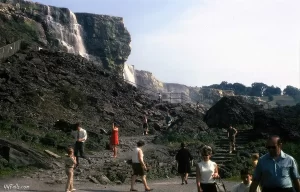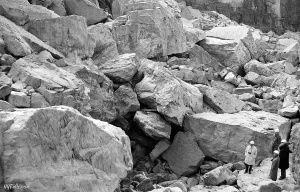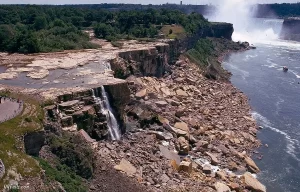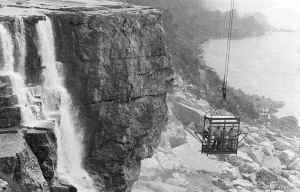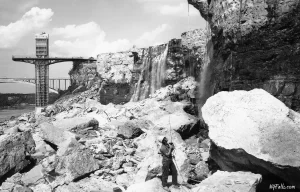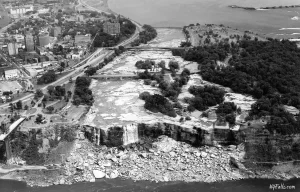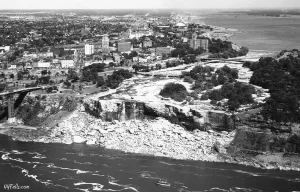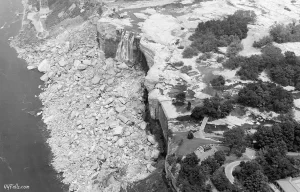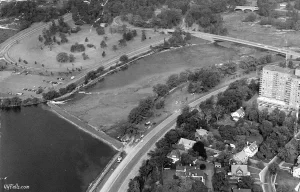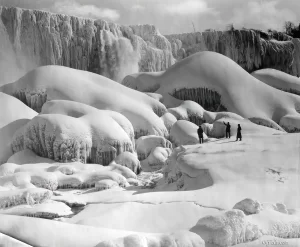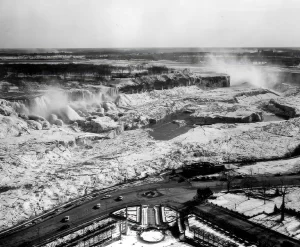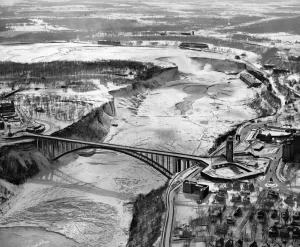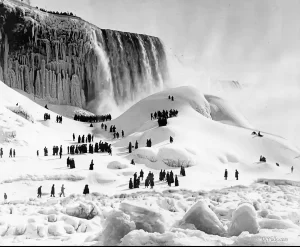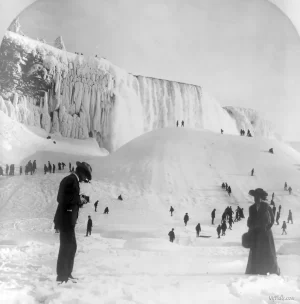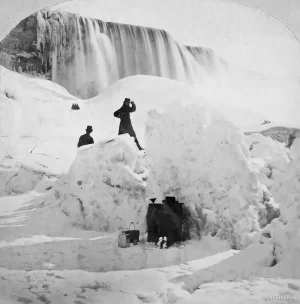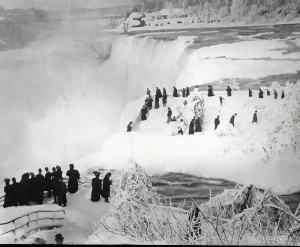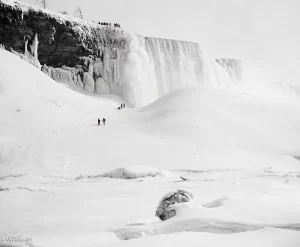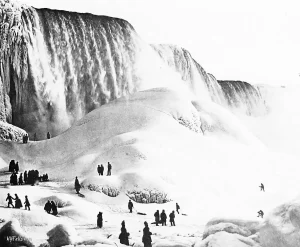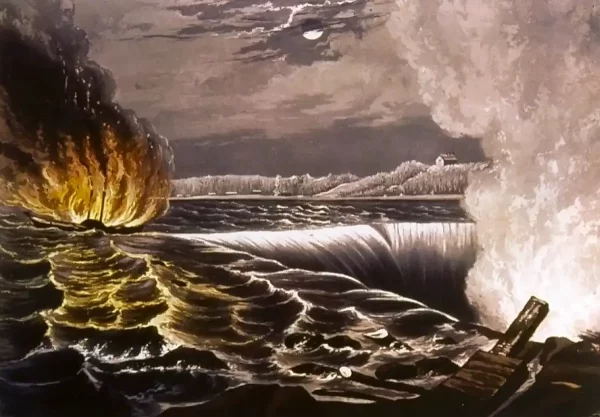Niagara Falls FAQ: History
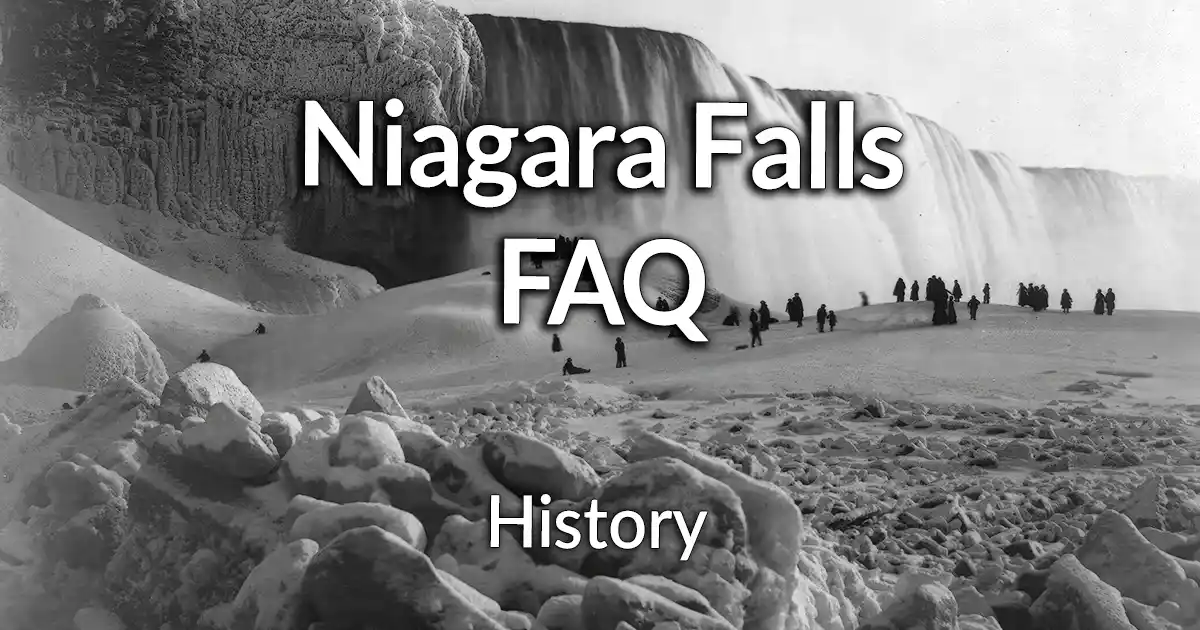
- Which side should I visit (US or Canada)?
- Do I need a passport to cross the border?
- What do children need to cross the border?
- Can I bring my dog/cat across the border?
- Can I walk across the Rainbow Bridge?
- What are the wait times for border crossing?
- Is my US driver’s license valid in Canada and vice versa?
- Is my automobile insurance valid while in Canada?
- Where can I exchange my currency?
- How tall is Niagara Falls?
- Are Niagara Falls the tallest in the world?
- What shape are the Falls?
- Where does all the water come from?
- How fast does water fall down Niagara Falls?
- Why is the water that shade of blue/green?
- What is that foam below the falls?
- Why do they call it Luna Island?
- What are the rock layers that make up Niagara Falls?
- How loud is Niagara Falls?
- Where did the name ‘Niagara’ come from?
- How old is Niagara Falls?
- Have the Falls ever stopped flowing?
- Has Niagara Falls the Falls ever frozen over?
- Has a boat ever gone over the falls?
- How many people have gone over the falls?
- Why isn’t the “Cave of the Winds” an actual cave?
- How far have the falls moved over time?
- How did they build the first bridge over the Niagara Gorge?
- How much of the water is being diverted for power generation?
- When and where was electricity first generated at Niagara Falls?
- Was electricity discovered at Niagara Falls?
- How many power plants are there at Niagara Falls?
- Which power station is the biggest?
- How do the power plants turn water into electricity?
- How much power is generated by Niagara Falls?
- How has power generation changed the Falls?
- What are those structures upstream from the falls?
- What does the International Control Dam do?
- When is the best time to visit Niagara Falls?
- Where is the nearest airport?
- How long should I plan to stay at Niagara Falls?
- Can I bring my dog to Niagara Falls?
- Do I have to pay to see Niagara Falls?
- Where can I park my car when visiting Niagara Falls?
- How many people visit the Falls each year?
- Which Fallsview hotel has the best view of the Falls?
- When do they light up the falls?
- Can I request colors for Niagara Falls lights?
- When are the fireworks?
- What spots offer the best view for watching the fireworks?
- How long does the park stay open?
- Are the Falls turned off at night?
- What is the legal age to drink alcohol and visit a casino?
- What Casinos are near Niagara Falls?
- What tours of Niagara Falls are available?
- Where can one play Golf at Niagara Falls?
- Where is the best view of Niagara Falls?
- What is the closest viewing area at Niagara Falls?
- Is Niagara Falls accessible to the disabled?
- How long is the Niagara River?
- What is the elevation difference between Lakes Erie & Ontario?
- When the Niagara River splits around Grand Island, does it become two rivers?
- Where is the Niagara River deepest?
- How did the Niagara Whirlpool form?
- In what direction does the Niagara Whirlpool flow?
- How deep is the water at the Niagara Whirlpool?
- What classes of rapids are in the Niagara River?
- What is Devil’s Hole?
- Where are the Niagara River Gorge walls the tallest?
Niagara Falls Visitors Guide
This Comprehensive Niagara Falls Historic Timeline is a part of our Niagara Falls Guide, a comprehensive look at The Falls, top attractions, and other awesome parks in the region, with a focus on photography and nature.
Where did the name ‘Niagara’ come from?
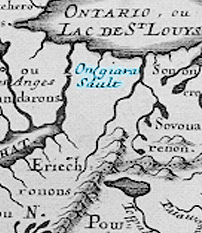 When Europeans first explored the Great Lakes basin, the tribe of the “thundering waters” were the inhabitants of the Niagara region. Although their actual name has been long forgotten, they were referred to as “Ongniaahra” by the Iroquois Nation of which they were a part. French settlers referred to them as the “Neutrals,” referring to their position in the Nation as mediators between tribes.
When Europeans first explored the Great Lakes basin, the tribe of the “thundering waters” were the inhabitants of the Niagara region. Although their actual name has been long forgotten, they were referred to as “Ongniaahra” by the Iroquois Nation of which they were a part. French settlers referred to them as the “Neutrals,” referring to their position in the Nation as mediators between tribes.
When European explorers began mapping the Great Lakes basins, they used accounts from local tribes to fill in gaps. It is speculated that eastern tribes may have described the Niagara region by referencing the Neutral tribe by their Iroquois name for the Niagara “thunder river”: Onguiaahra. Like with many Native American names, it was subsequently “bastardized” by map makers and eventually became Niagara.
It is not known whether or not “Ongniaahra” was the original name for the region or for its inhabitants. The Neutrals were wiped out by 1653 during a tribal war with the Seneca tribe.
How old is Niagara Falls?
Niagara Falls is estimated to be around 12,000 years old. It was formed at the end of the last Ice Age when glaciers receded, allowing water from the Great Lakes to flow through the Niagara River and over the Niagara Escarpment.
Have the Falls ever stopped flowing?
Yes, several times in recorded history.
The falls once ran dry because of ice. Read more about that in the section below.
1953 Control Dam Construction
With erosion taking its toll on the edges of the Horseshoe Falls, it was decided to reinforce those sections before damage was done to tourist attractions or lives were lost. In 1953 a control dam is constructed to divert more water over the American Falls, which change the appearance of the Horseshoe Falls enough to warrant corrective action. Horseshoe Falls was not to be turned off completely, rather sections would run dry periodically as construction progressed. With the international control dam helping to alleviate some of the flow over the Canadian (Horseshoe) Falls, a series of coffer dams cleared the way for workers to remove rock from the edges of the Falls, creating a more level crest line for a more consistent flow across the width. Additional work was performed to reinforce the Table Rock, while the Terrapin Point viewing platform was extended out over the river, reducing the width of the falls by about 300 ft.
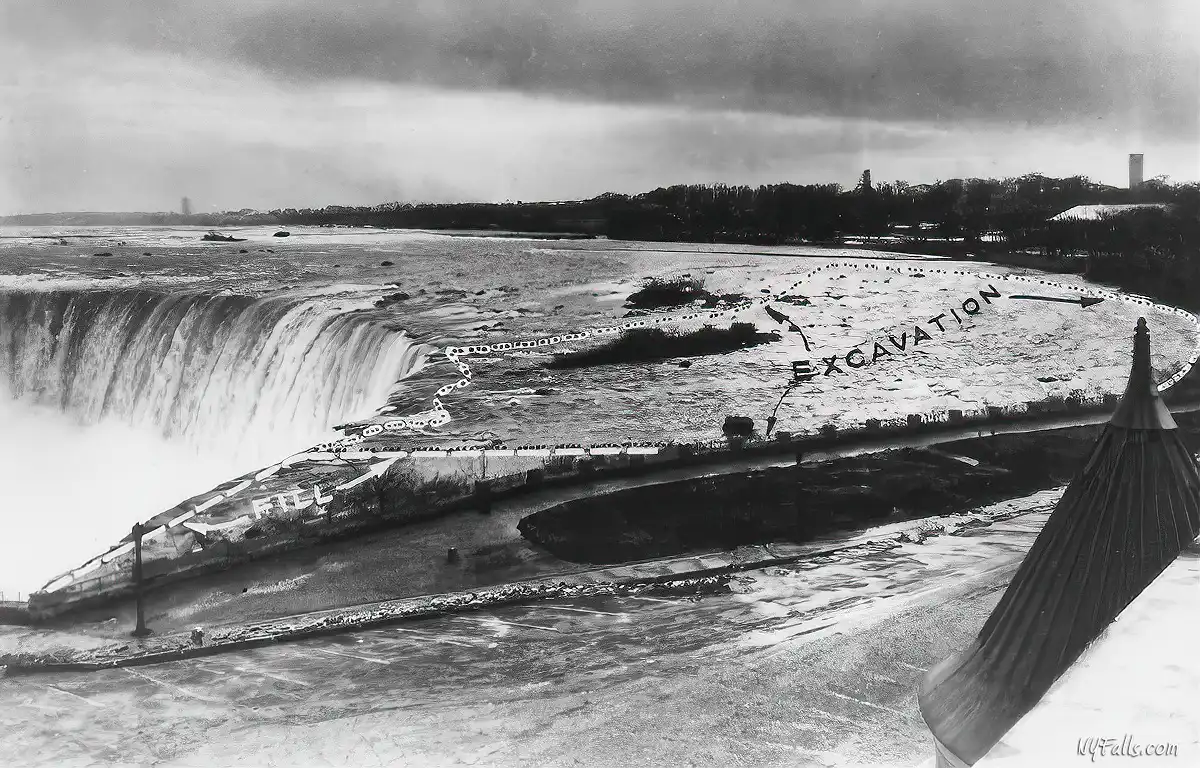
Army Corps of Engineers coffer dam in 1969
The American Falls ran nearly dry for months in 1969 when the US Army Corps of Engineers built a coffer dam at the southern end of Goat Island to divert the water to the Horseshoe Falls. On June 12, 1969, the American Falls slowed to a trickle and engineers began studying it. Their purpose was to assess the condition of the falls, make repairs to unstable sections, and collect data to recommend a course of action to improve or maintain its beauty – possibly by removing the boulder pile at its base. Unfortunately, two bodies were found amongst the rubble at the base of the falls, both presumed to be suicides.
The “de-watered falls” became a popular sight, with tourist numbers breaking all-time records. NY State Parks even opened a new attraction – allowing visitors to walk on the dry river bed above the falls. Over the course of 5 months, concrete was used to fill cracks in the bedrock and large steel bolts were used to reinforce trouble areas at the crest. On November 27th, 1969 the coffer dam was dismantled and the American Falls was flooded once again. After reviewing the data, the Army Corps of Engineers concluded a year later that although removing the boulders below the falls was a possibility (at the cost of $10 million) it was recommended to leave them be.
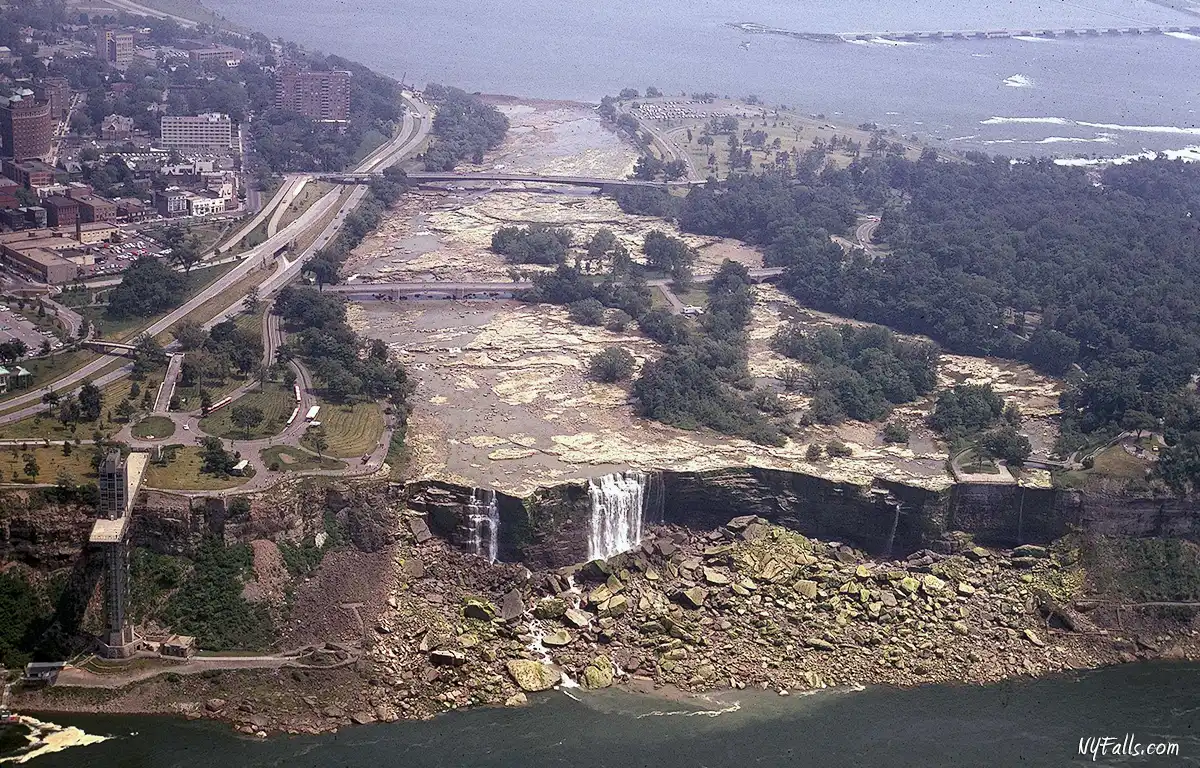
Has Niagara Falls ever frozen over?
Yes, but not fully frozen solid. Niagara Falls can experience partial freezing or ice formations during extremely cold weather conditions, which is not an uncommon occurrence in the winter months of Upstate NY and Ontario. However, it is important to note that the falls do not completely freeze over, and the water continues to flow beneath the ice.
The degree of freezing varies depending on the severity and duration of the cold temperatures. When temperatures drop significantly, ice formations can be observed along the edges of the falls. Mist freezes on any surface it reaches, coating the surrounding cliffs and the nearby riverbanks and park railings with a thick slippery crust. These ice formations can create stunning and unique visual displays, often attracting visitors who are captivated by the winter beauty of the falls. It definitely makes visiting during a cold blast a worthwhile trip.
It is worth mentioning that the volume of water flowing over the falls is immense, and it would require an extended period of extremely cold temperatures for the falls to freeze completely, which is a rare occurrence. American Falls tends to freeze more dramatically than the Canadian (Horseshoe Falls) because far less water flows over it (about 7%).
Ice Bridges over the Niagara River
Below the falls, ice bridges, or solid blocks of ice over the Niagara River will form during long periods of sub-freezing temperatures. These ice bridges tend to settle, collect, and grow below the falls. In the 1880s, there was an attraction operated in the winter months where a set of covered stairs brought tourists down into the gorge to the ice bridges below American Falls. There, a cabin served refreshments. People would climb ice hills, toboggan down, and catch close-up views of the falls from the edge of the ice.
Three people died when they fell through melting ice in 1912 and the tradition ceased.
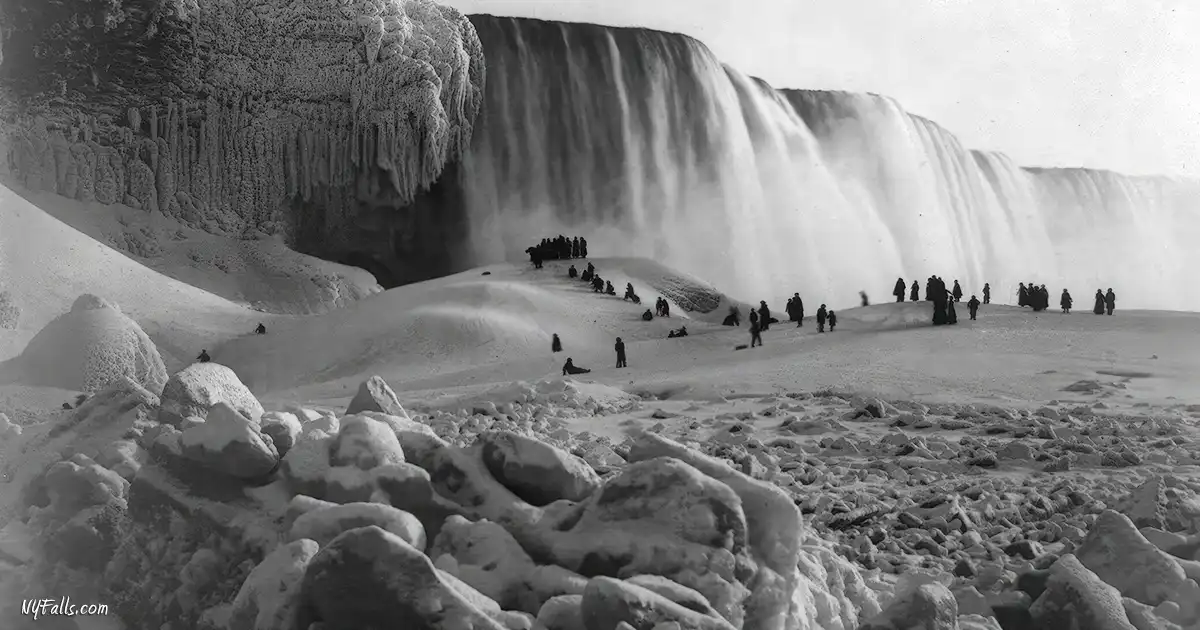
Ice Dam – When Niagara Falls stopped flowing
Imagine what went through residents’ minds when the continuous roar they had grown accustomed to for years all of a sudden went silent in the middle of the night of March 29, 1848. A cold spell caused a massive buildup of ice across the east end of Lake Erie near the Niagara River, and strong winds packed ice at the inlet of the river, choking its flow and bringing the Falls to a mere trickle.
Niagara Falls residents were awoken by this unusual silence and many of them, unaware of the cause, began to proclaim the “beginning of the end.” Mills stopped working, the Maid of the Mist lay lilted on the rocks, and the sounds of various onlookers proclaiming answers filled the air. People explored the river bed, finding coins and artifacts from the War of 1812 amongst the floundering fish. Within hours the booming tourist industry began to take advantage of the situation. Some exhibitions and side shows quickly moved their act to the river bed. The Maid of the Mist crew began blasting hazardous boulders to make their ventures easier.
No one knew the cause, and they continued to suspect the worst. People packed every church, praying for a return of the water and a sparing of their souls. It wasn’t until the night of March 31st that a loud roar signaled the return of the flow to the Falls.
The American Falls, which carries only a fraction of the full flow, is much more likely than the Horseshoe Falls to freeze over. It has only happened on five recorded occasions; 1848, 1909, 1936, 1938, and 1949.
Ice dams continued to hinder flow and power production at the falls for decades since, although never brought the flow down as much as it did on that day. In 1964 an “Ice Boom” was installed at the entrance to the Niagara River to stop ice from flowing into the river. It spans 2 miles and skims the surface of the water, holding back ice, while letting the water flow underneath. It’s removed in the spring and reinstalled every winter.
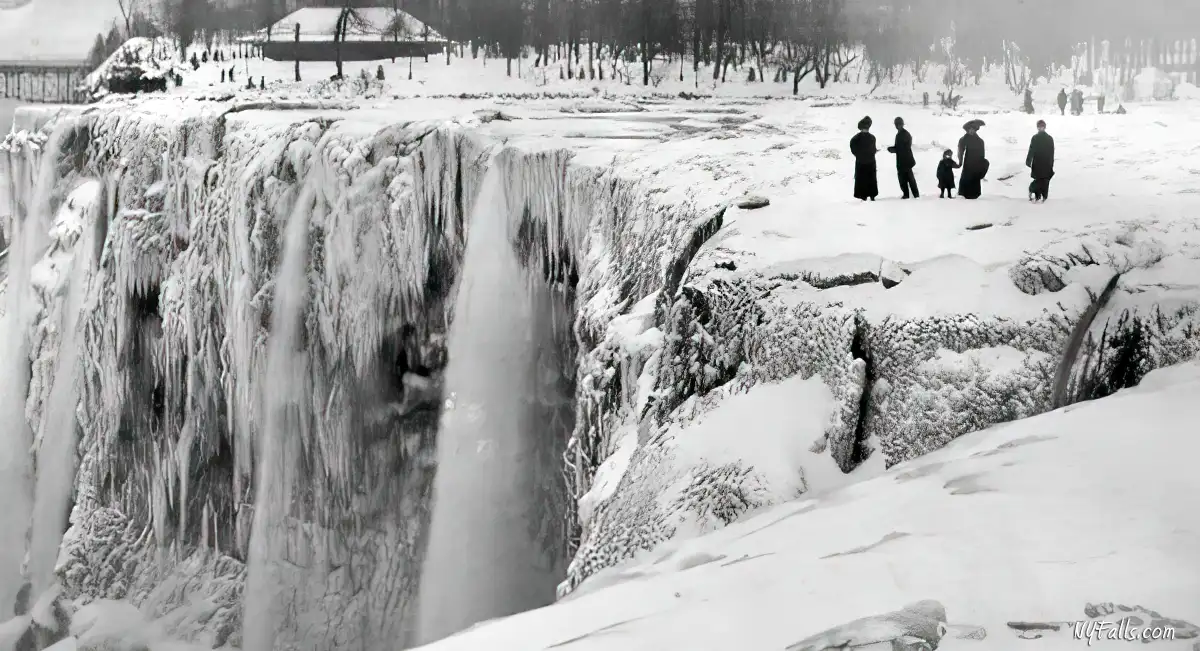
Has a boat ever gone over the falls?
Yes. During the dawn of Niagara Falls tourism, a group of local hotel owners, led by William Forsyth of the Pavilion Hotel, organized the first tourist stunt at Niagara falls. Their plan was to send a ship full of “ferocious animals” over the falls, and hopefully draw thousands of onlookers. They hoped many of which would patronize their establishments. They advertised the event heavily, and their efforts paid off. Nearly 15,000 people showed up on September 8, 1827 to watch the ship plummet. The event planners took an old lake schooner, the “Michigan,” and dressed it up as a pirate ship—complete with hay-stuffed dummies as crew. The “ferocious animals” they stocked it with turned out to be a buffalo, two small bears, two raccoons, a goose and a domestic dog.
The ship was set adrift upstream from the horseshoe falls, but before it could fall down the cataract the hull scraped along rock outcroppings in the rapids and began to break apart. The bears seized this opportunity and escaped, swimming safely to Goat Island. The rest of the animals went down with the ship. It is said that a single goose survived, and he became quite a draw for a local hotel.
An attempt was made to repeat the stunt in 1931, when local business owners sent 9-year-old steamer, the “Superior,” over the falls. It wasn’t packed with animals, but crowds wanted to see it, because it was a famous ship: the second steamer to sail on Lake Erie. It didn’t quite make it to the falls. It became stuck on an island of rocks for hours and the crowds left disappointed. It wasn’t until the water level rose that it finally went over the brink—with little fanfare.
Another ship was sent deliberately over the falls in 1837 during the Upper Canada Rebellion. William Lyon Mackenzie, a journalist who was very critical of the Upper Canadian government, formed an armed rebellion against them. He and 700 of his “Patriots”, occupied Navy Island on the Niagara River, calling themselves “The Republic of Canada.” The steamer “Caroline,” a vessel chartered by Mackenzie to run supplies, was caught by the British, set ablaze, and run over the Falls. Early in 1938 the rebellion was crushed and Mackenzie fled to the United States.
How many people have gone over the falls?
Including Jessie Sharp (who went over in a Kayak) and Robert Overacker (who made an attempt in a jet ski) and including balls, rubber tubes and various crafts, there have been a total 15 people (or should I say “Daredevils”) that challenged the Horseshoe Falls in a craft or barrel. One man, Kirk Raymond Jones, went over with nothing but the clothes on his back. Of those that intentionally went over the falls, 6 died. 2 people (Steven Trotter and David Munday) went over the falls twice and lived.
On March 10, 2009 an unnamed man went over the Horseshoe Falls in a failed suicide attempt. Rescuers pulled him from the pool below. The force of the Falls left him completely naked, in shock and with a large gash on his head. He is the third person to ever survive the plunge without a craft.
Every year there are about a dozen suicides at the Falls, from people entering the rapids and going over. Some change their minds at the last minute and require rescue. Others die; leaving authorities wondering if it was an intentional suicide or an attempt at becoming a famed Niagara Daredevil. Over 5,000 bodies have been recovered from the bottom of the falls since 1850.
An attempt at becoming a Niagara Falls daredevil (or suicide attempt case) will set you back at least $10,000 in fines plus the costs of your rescue. For more information on Niagara daredevils, check out the Historical Timeline.
Why isn’t the “Cave of the Winds” an actual cave?
One of the more popular attractions on the American side, the Cave of the Winds brings you close enough to the Bridal Veil Falls to get totally soaked by it. Visitors who don the yellow souvenir poncho and ride the elevator 175 feet into the Niagara gorge for their fist time are often surprised that there is no cave at all.
There used to be a cave. It was actually about 100 feet of strong overhanging dolomite bedrock at the crest of Bridal Veil Falls that projected the water forward leaving a “cavern” with one side rock and another water, under which tourists would walk. Although the cave was visible from atop the gorge, it wasn’t until the Biddle Staircase was built in 1829, that people had a chance to enter it. It was originally dubbed Aeolus’ Cave, after the Greek god of winds, but the name didn’t stick and it was commonly referred to as the “Cave of the Winds.”
Measuring 130 feet (40 meters) high, 100 feet (30 meters) wide and 30 feet (9 meters) in depth it quickly became one of the most popular attractions at the Falls after guided tours began in 1841. Its popularity continued through the early 1900’s when a walkway leading to the cavern was constructed. On September 6, 1920, tragedy struck when a portion of the cave collapsed during a tour, killing 3 and injuring several others. Despite this misfortune, the attraction continued to thrive and in 1925, elevators were installed in order to get more people to the cave faster.
Visitors continued to enjoy the Cave of the Winds until another rock collapse occurred at Prospect Point (on the other side of the American Falls) in 1954 raised doubts about the integrity of that rock in the gorge. Engineers determined that the huge slab of dolomite that served as the ceiling for the cave, was in danger of succumbing to erosion and collapsing. In 1957, tours behind the Bridal Veil Falls came to an end when the Cave of the Winds was demolished with controlled dynamite blasts.
Today the tour continues, but stops short of going behind the Falls. The trademark red wood “Hurricane Deck” is built out onto the boulders to the south of the Bridal Veil Falls every spring. Each year the deck is reconstructed to allow visitors to get as close as safely possible to the spay in front of the Falls (roughly 20 feet or 6 meters). The deck isn’t anchored with bolts to a foundation, rather builders wedge planks into the talus below the falls to give the deck its support. The deck is dismantled in early November.
How far have the falls moved over time?
The Falls are roughly 12,000 years old. Over that time is has moved and morphed from its beginnings as a single waterfall at the edge of the Niagara Escarpment near Lewiston/Queenston 7 miles downstream to its current location The birthplace of the Falls can be seen from Queenston Heights Park, ON or the Earl Brydges Artpark State Park in NY. At the time the Falls was an estimated 40 feet (12 meters) tall and the flow was roughly a quarter of what it is today.
With glaciers still receding after the last ice age and the Great Lakes forming, the water flow through the Niagara was inconsistent for ages. 11,000 years ago, the northern Great Lakes’ water flow bypassed the southern Niagara route and its erosion, and thus recession, slowed drastically. It wasn’t until roughly 5,500 years ago that the flow returned and erosion sped up again.
Around 4,200 years ago, the Falls reached a dramatic point in its journey. It uncovered a massive pre-glacial gorge−an ancient river valley gouged 300 feet into the bedrock. Glacial activity buried this gorge with silt, sand, and stone − loosely packed by geological standards. When the Falls hit the junction where the Niagara River crossed Saint David’s Buried Gorge it began tearing through the loosely packed fill at an alarming rate. At this time the Falls probably wasn’t a waterfall at all, but rather a muddy mess of rapids as it excavated the filled gorge. The 90 degree turn at the present-day Whirlpool marks where the Falls met the ancient gorge, turned and began tearing it apart.
Within a few hundred years the Falls carved out the Whirlpool Rapids. Its fast recession leaving the gorge narrow and perfect for turbulence. As the falls turned south once again it slowed, creating a wider gorge and deeper pools.
When the first Europeans came to America, Niagara was still a single waterfall. It wasn’t until 600 or so years ago that the recession reached Goat Island, which split the crest line into the American and Horseshoe Falls. Even as the tourism industry started ramping up in the early 1800s, the Falls were receding at a noticeable rate – about 2 feet a year. The diagram to the left shows how the Horseshoe Falls have receded since 1678.
Today, with most of the water flow diverted for generating electricity, erosion has slowed to barely measurable rates. It is estimated that the Falls recede a few inches every 10 years. Important features, like prominent rocks along the crest of the American Falls have been bolted in place, and probably won’t be dislodged by natural means for a long while. Goat Island is safe for a long time as well. Under natural conditions it could be eroded away (and the Falls would merge) in roughly 2,500 years. If nature were to take its course, the falls would eventually make it to Lake Erie and disappear, creating a a steep gorge of varying widths along the way.
With a recession of just over 7 miles in 12,000 year, Niagara Falls is easily one of the fastest receding waterfalls in the World.
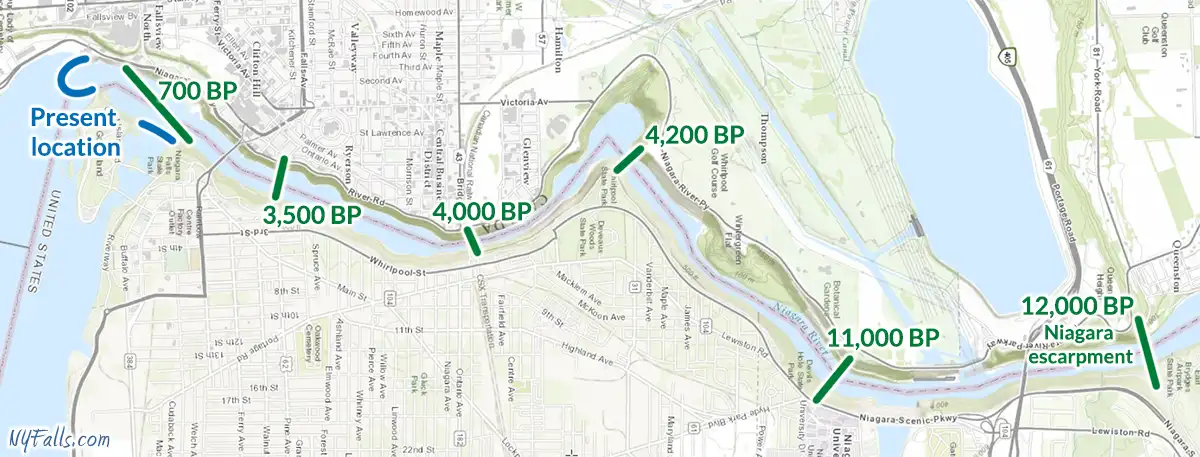
How did they build the first bridge over the Niagara Gorge?
If the Niagara gorge at the rapids was unpassable given the technology at the time, how did engineers begin to connect each side of the 800 foot (244m) gorge to form a bridge?
Engineers have started construction of both sides of a bridge, only to join them in the middle. In the 1840s, and with 1840s-era equipment, this would have carried a high risk of error.
Engineer Charles Ellet Jr. was commissioned to build a bridge over the Niagara River in 1847. The point chosen was just above the beginning of the Whirlpool Rapids, as it was the narrowest point of the gorge. With a 200 ft drop and dangerous, roaring rapids below, how were they to begin to connect the two sides, let alone communicate?
The solution was to hold a contest, specifically a kite-flying contest to fly and land a kite across the gorge. On day two, a 16-year-old American boy, Homan Walsh, successfully landed his kite in Ontario, taking the prize and enabling the team of engineers and construction workers to begin. They tied the string to a tree, then drew heavier cords across the line, growing the connection in strength until it was strong enough to draw a heavy wire cable.
Towers were erected on each side and a metal basket was strung along the cable between them. From May to August 1848 over 100 people paid $1 to travel across the gorge (and back) in that basket.
The bridge, a mere 3 ft wide, was completed in July of 1848. It was free to cross, and 25 cents to return.This fee was apparently not approved by the local governments that approved and funded the bridge, but by the lead engineer Charles Ellet Jr. and his brother, who pocketed the income. They were later ordered by the court to cease collections.
The bridge was dismantled and replaced by a larger one 6 years later.
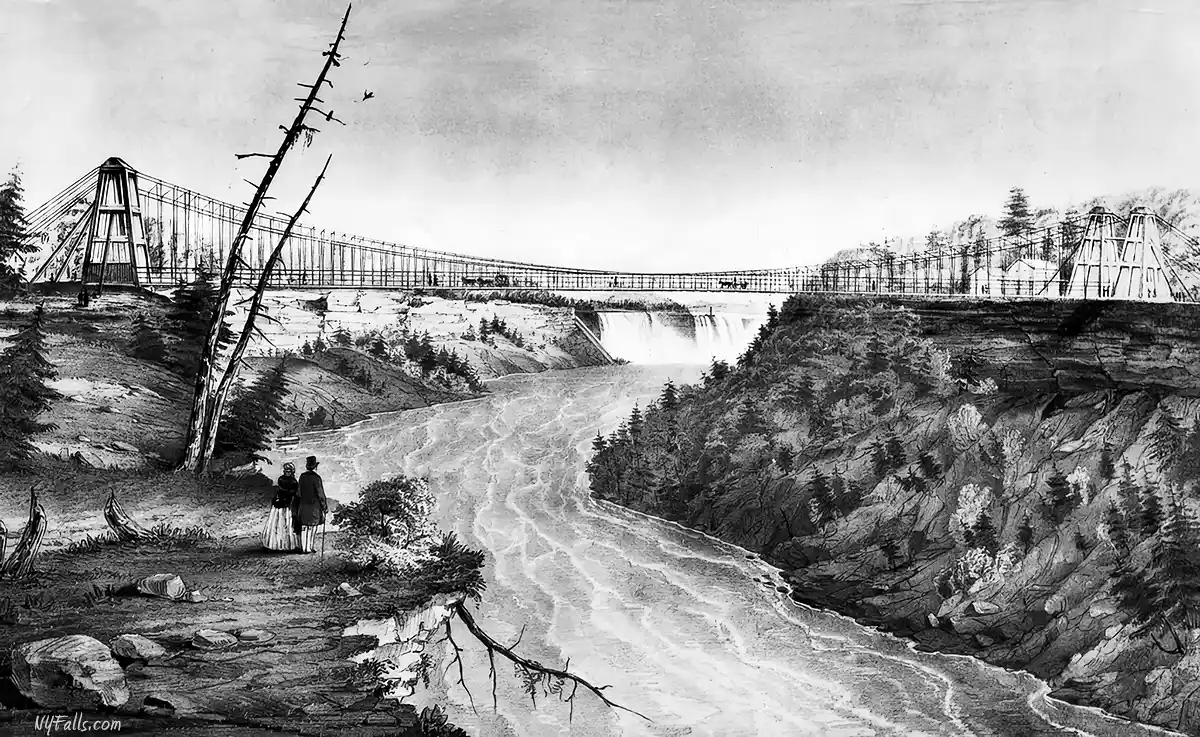
Niagara Falls Visitors Guide
Filled with facts and figures, tips, photos, and profiles of parks and main attractions, our guide to Niagara Falls shows you all the amazing stuff the region has to offer, while leaving out the gaudy tourist traps.




